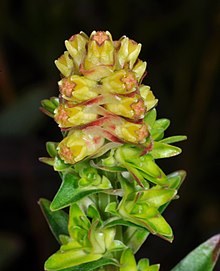Penaeaceae
| Penaeaceae | ||||||||||||
|---|---|---|---|---|---|---|---|---|---|---|---|---|

|
||||||||||||
| Systematics | ||||||||||||
|
||||||||||||
| Scientific name | ||||||||||||
| Penaeaceae | ||||||||||||
| Sweet ex Guill. |
The Penaeaceae are a family of plants in the order of the myrtle-like (Myrtales). The approximately 30 species occur in eastern and southern Africa and on St. Helena. The center of biodiversity is the capensis .
Description and ecology


The species of the family are evergreen shrubs , mostly they are small and erikoid . The simple, leathery leaves are opposite to most of the other myrtle-like leaves, but there are taxa with whorled leaves. The leaf margins are smooth. Stipules are present or absent.
The flowers stand alone or in inflorescences . The hermaphroditic flowers are radial symmetry and four-fold. There are only four bracts . There is only one circle with four free, fertile stamens with short stamens . Four fruit leaves are a top permanent ovary overgrown. In each flower there is only one stylus with a cephalic or four-lobed stigma .
Only with Olinia are stone fruits , with the other genera capsule fruits are formed. The seeds usually have an elaiosome . In many species, the seeds are spread by ants ( myrmecochory ).
The basic chromosome number is x = 10.


Systematics and distribution
The Penaeaceae family was established in 1828 by Robert Sweet in Jean Baptiste Antoine Guillemin : Dictionnaire classique d'histoire naturelle , 13, p. 171. The type genus is Penaea L. The two genera Olinia and Rhynchocalyx of the monogeneric families Rhynchocalycaceae LASJohnson & BGBriggs and Oliniaceae Harv. & Sond. were incorporated into the Penaeaceae family. It belongs to the order of the Myrtales .
The family Penaeaceae is divided into two tribes and contains about nine genera with about 30 species :
- Tribe Olinieae Horan. : It contains only one genus:
- Olinia Thunb. : The five to ten species are native to East Africa , in the Capensis , in an area in West Africa and on the island of St. Helena .
- Tribe Penaeeae DC. : It contains about seven genera only in the Capensis:
- Brachysiphon A.Juss. : Of the approximately five species, one thrives in the arid mountain ranges in central-southern South Africa and the others only occur in the southwestern Western Cape .
- Endonema A.Juss. : The only two species occur only in the Riversonderend Mountains in the Western Cape.
-
Glischrocolla (Endl.) A.DC. : It contains only one type:
- Glischrocolla formosa (Thunb.) R.Dahlgren : This rare species is endemic to the Western Cape in the northern “Hottentots Holland” mountains at altitudes between 1200 and 1400 meters.
-
Penaea L .: The approximately four species occur from the Cape Peninsula to Port Elisabeth in the Capensis, for example:
- Penaea mucronata L. The sarcocolla resin (also known as sarcocolla and Persian gum ), which was also used in the pharmaceutical industry, was obtained from these and other plants.
-
Saltera Bullock (Syn .: Sarcocolla Kunth ): With only one species:
- Saltera sarcocolla (L.) Bullock ( Penaea sarcocolla L. ): It occurs in the Capensis.
- Sonderothamnus R.Dahlgren : it contains one or two species in capensis.
- Stylapterus A.Juss. : The approximately eight species mostly have very small distribution areas in the southwestern Western Cape.
- Incertae sedis:
-
Rhynchocalyx olive. : It contains only one type:
- Rhynchocalyx lawsonioides olive. : It is endemic to the eastern South African provinces of KwaZulu-Natal and Eastern Cape , where it grows in the coastal forests along the Indian Ocean .
-
Rhynchocalyx olive. : It contains only one type:
swell
- The Penaeaceae family on the AP website. (Sections Description, Distribution and Systematics).
- The families Penaeaceae , Rhynchocalycaceae and Oliniaceae at DELTA by L. Watson and MJ Dallwitz. (Section description).
Individual evidence
- ^ Penaeaceae at Tropicos.org. Missouri Botanical Garden, St. Louis
- ↑ Angiosperm Phylogeny Group : An update of the Angiosperm Phylogeny Group classification for the orders and families of flowering plants: APG III. In: Botanical Journal of the Linnean Society. Volume 161, No. 2, 2009, pp. 105-121, DOI: 10.1111 / j.1095-8339.2009.00996.x .
- ↑ Penaeaceae in the Germplasm Resources Information Network (GRIN), USDA , ARS , National Genetic Resources Program. National Germplasm Resources Laboratory, Beltsville, Maryland.
- ↑ Dieter Lehmann: Two medical prescription books of the 15th century from the Upper Rhine. Part I: Text and Glossary. Horst Wellm, Pattensen / Han. 1985, now at Königshausen & Neumann, Würzburg (= Würzburg medical-historical research. Volume 34), ISBN 3-921456-63-0 , p. 249 f. ("A piece in the apotecken is called sarcocolla").
- ↑ Jürgen Martin: The 'Ulmer Wundarznei'. Introduction - Text - Glossary on a monument to German specialist prose from the 15th century. Königshausen & Neumann, Würzburg 1991 (= Würzburg medical-historical research. Volume 52), ISBN 3-88479-801-4 (also medical dissertation Würzburg 1990), p. 168 ( sarcocolla : resinous excretion of Astragalus sarcolla Dymock, Sarcocolla fuscata (L. ) DC., Sarcocolla squamosa (L.) Kunth or Penaea mucronata L.)